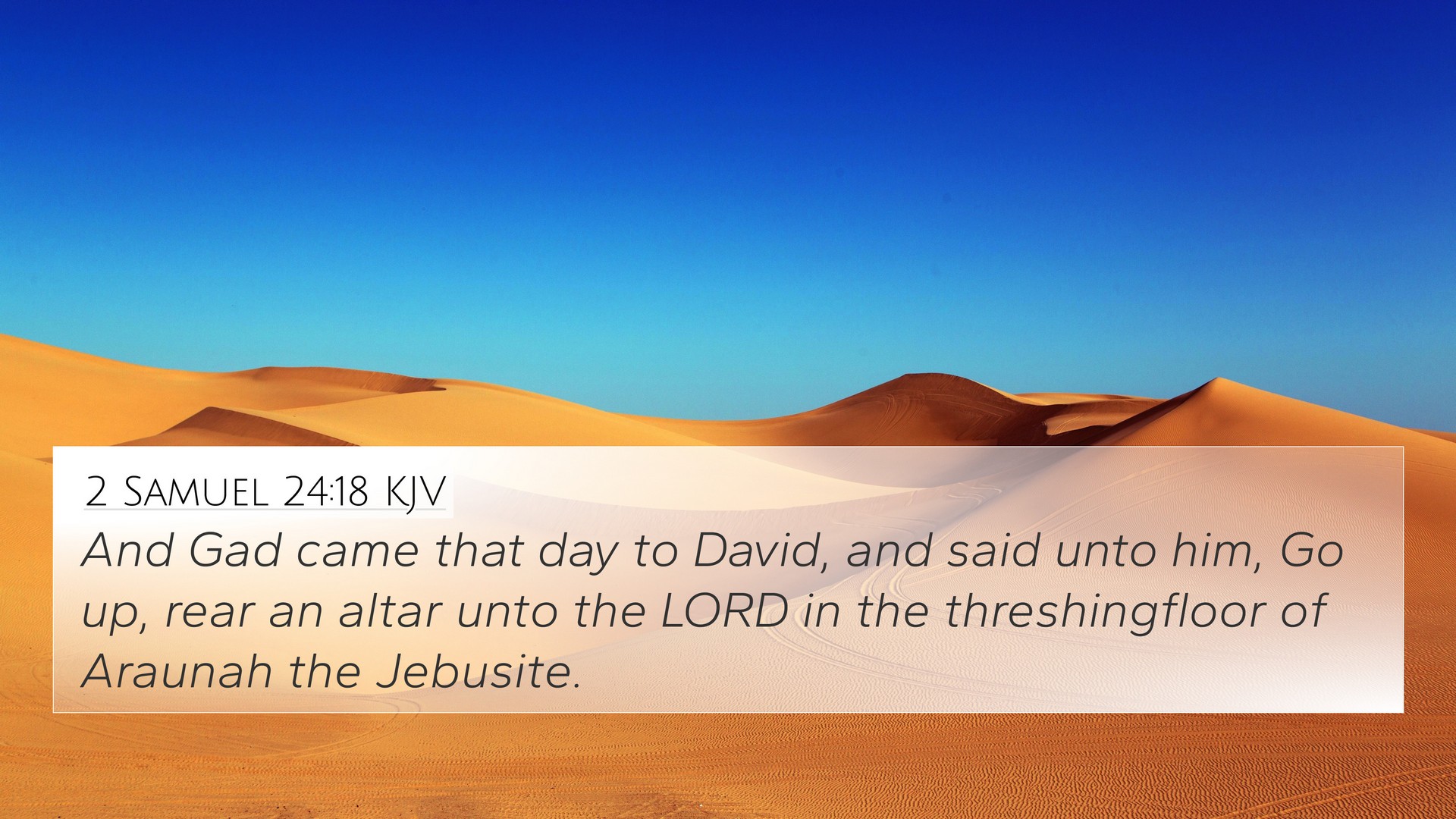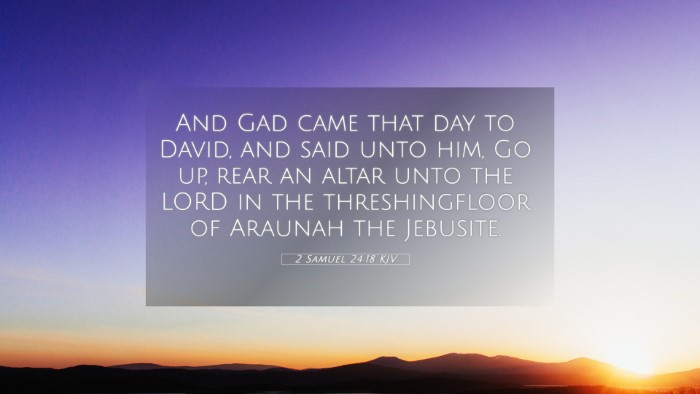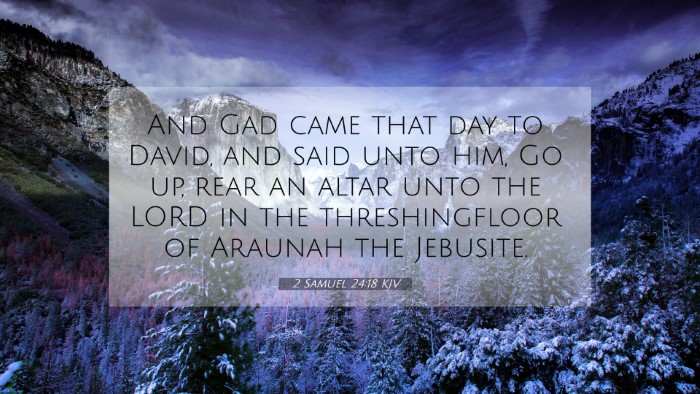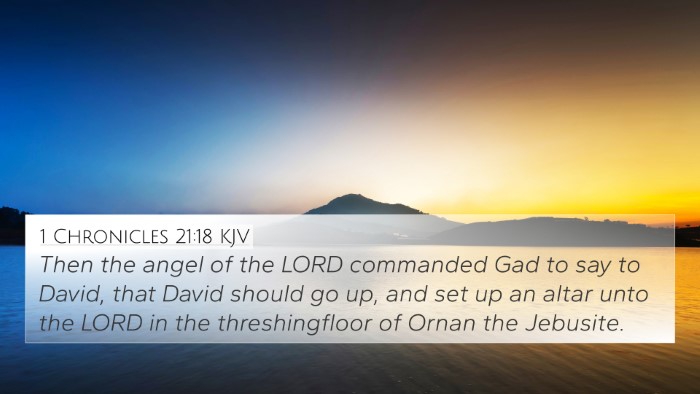Understanding 2 Samuel 24:18
The verse 2 Samuel 24:18 states: "So Gad came to David that day and said to him, 'Go up, erect an altar to the Lord on the threshing floor of Araunah the Jebusite.'" This verse marks a pivotal moment in the narrative where the prophet Gad instructed King David to build an altar, signaling repentance and an appeal for God’s mercy.
Meaning and Interpretation
This section endeavors to unravel the insights from various public domain commentaries on this verse, drawing from the substantial ideas presented by notable scholars such as Matthew Henry, Albert Barnes, and Adam Clarke.
Matthew Henry's Commentary
Matthew Henry emphasizes the importance of obedience to divine instruction. He notes that Gad's command represents a direct communication from God, urging David to respond to the consequences of his earlier actions (the census). The act of building an altar is portrayed as a necessary step for atonement, reflecting King David's role not merely as a ruler but a servant of God seeking reconciliation.
Albert Barnes' Notes
Albert Barnes observes that the choice of the location—the threshing floor of Araunah—holds significant theological implications. The threshing floor symbolizes a place where separation occurs, which can be seen as a metaphor for the spiritual separation caused by sin. By building the altar here, David would be acknowledging his wrongs and the need for purification. Barnes also connects this event to the overarching theme of sacrificial worship, highlighting that this act would lead to national restoration and divine favor.
Adam Clarke's Commentary
Adam Clarke provides insights into the motivations behind David's actions and the historical context surrounding this particular altar. He notes that building an altar was a common act of worship in Israel that required sincere repentance. Clarke asserts that this moment signifies David's obedience and willingness to rectify his mistakes before God. He also emphasizes how this act not only had immediate implications for David but also set a precedent for future generations, reinforcing the importance of humility and worship in Israel's national identity.
Bible Cross-References
- 1 Chronicles 21:18-26 - This parallel account details the same event but expands on the significance of the altar's construction.
- Genesis 8:20 - The act of building an altar is echoed in Noah's offering to God after the flood, demonstrating a timeless practice of worship.
- Exodus 20:24 - God’s instructions on building altars in the Old Testament emphasize the necessity of sacred places for worship.
- 1 Kings 3:4 - Solomon’s worship at Gibeon parallels the importance of altars in seeking God’s guidance and favor.
- Psalm 51:17 - David's understanding of a broken spirit as an acceptable sacrifice connects to his actions in this verse.
- Hebrews 13:15 - The New Testament encapsulates the concept of sacrifices of praise, drawing connections to Old Testament worship.
- Romans 12:1 - Paul emphasizes living sacrifices as a New Testament fulfillment of the concept of presenting oneself to God, similar to building an altar.
Thematic Connections
This verse, and its surrounding context, presents several themes significant for theological reflection:
- Repentance: David’s action upon receiving God’s command demonstrates a heart leaning towards repentance, essential in the believer's relationship with God.
- Worship: The location of the altar signifies the integral role of physical spaces in the worship experience.
- Divine Guidance: Gad’s prophecy highlights the importance of divine communication through prophets, a recurrent theme throughout Scripture.
How to Use Bible Cross-References
Utilizing cross-references can deepen understanding and establish thematic connections between Scripture. Here are some tools and techniques:
- Bible Concordance: Use to find words and references related to specific themes or events.
- Cross-Reference Guides: Helpful for discovering related verses that illuminate the meaning of a particular text.
- Bible Study Methods: Comparative analysis of various verses can uncover deeper spiritual truths and connections.
- Inter-Biblical Dialogue: Engage with both Old and New Testament texts to understand their interconnectedness and collective message.
Conclusion
In summary, 2 Samuel 24:18 serves as a crucial juncture in King David’s journey of faith—a moment that reflects themes of repentance, divine instruction, and the importance of worship. By exploring this verse with the insights of established commentaries and considering its cross-references, one can gain a richer, more nuanced understanding of its implications for both ancient and modern believers.




